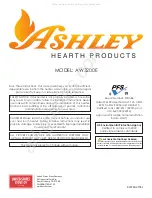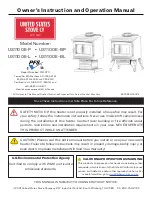
43
3. Lighting the stove
Important safety information
•
The wood burning stove will become warm during use and therefore it should be treated with all
necessary caution.
•
Never keep easily combustible fluids such as petrol in the vicinity of the wood burning stove.
•
Never use easily combustible fluids to light the fire in the wood burning stove.
•
When lighting a fire, it is important to get the fire burning fast. If the fire does not start quickly and
wood only smoulders, it can cause strong smoke formation and in worst case cause an explosive
ignition of the flue gasses, which can damage the stove.
•
Never empty the ashpan when the wood burning stove is warm. Embers may still be found in the
ashpan for up to 24 hours after the fire has gone out. Please wait to empty the ashpan until you
are sure that there are no embers in the ash.
•
The door should be kept closed while the wood burning stove is in use. While lighting the fire, the
door can stand ajar for the first few minutes.
•
When putting logs in a hot stove, you must always open the primary air intake and make sure that
the wood ignites within 2-3 minutes. If the wood does not ignite, add some ignition products and
ignite them manually.
•
In the event of a chimney fire: Close all the dampers on the wood burning stove and call the fire-
fighting service.
3.1 Damper
The stove is equipped with different dampers, which regulates the combustion air: primary, secondary, and
tertiary air supply. The primary air is used at the beginning to get the fire going, the secondary air keeps the
fire burning evenly, and the tertiary air ensures that flue gasses are burned. You must always add secondary
and tertiary air, while firing the stove.
The damper allows you to adjust the stove according to the chimney draft and the heat output you require.
The longer the damper is pulled out, the more air is added and the more powerful the combustion. The
illustration below shows the stove seen from the front with the dampers indicated. Use edge of door to read
position of inlet air:
1: Fully open primary, secondary, and tertiary air
inlet. This position can be maintained with the
Aduro key, which must be placed in the two holes.
2: Closed primary air inlet, fully open secondary
and tertiary air inlet.
3: Closed primary air inlet, half way closed
secondary air inlet, and fully open tertiary air inlet.
4: Closed primary and secondary air inlet, fully
open tertiary air inlet.
5: Regulator pushed all the way in. All air inlet
closed.
Summary of Contents for 9.7 Lux
Page 18: ...18 9 Pr vningsattest...
















































